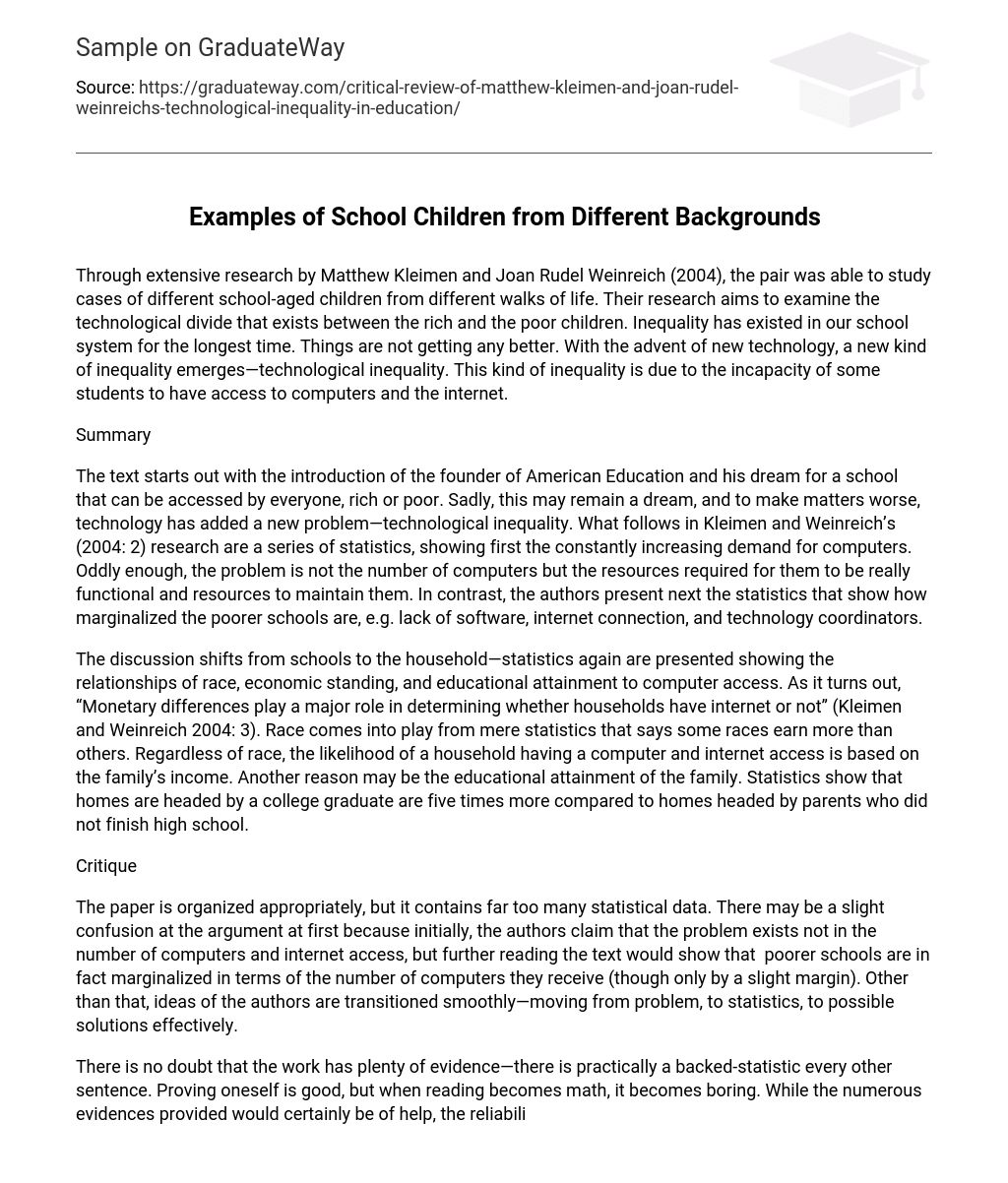Through extensive research by Matthew Kleimen and Joan Rudel Weinreich (2004), the pair was able to study cases of different school-aged children from different walks of life. Their research aims to examine the technological divide that exists between the rich and the poor children. Inequality has existed in our school system for the longest time. Things are not getting any better. With the advent of new technology, a new kind of inequality emerges—technological inequality. This kind of inequality is due to the incapacity of some students to have access to computers and the internet.
Summary
The text starts out with the introduction of the founder of American Education and his dream for a school that can be accessed by everyone, rich or poor. Sadly, this may remain a dream, and to make matters worse, technology has added a new problem—technological inequality. What follows in Kleimen and Weinreich’s (2004: 2) research are a series of statistics, showing first the constantly increasing demand for computers. Oddly enough, the problem is not the number of computers but the resources required for them to be really functional and resources to maintain them. In contrast, the authors present next the statistics that show how marginalized the poorer schools are, e.g. lack of software, internet connection, and technology coordinators.
The discussion shifts from schools to the household—statistics again are presented showing the relationships of race, economic standing, and educational attainment to computer access. As it turns out, “Monetary differences play a major role in determining whether households have internet or not” (Kleimen and Weinreich 2004: 3). Race comes into play from mere statistics that says some races earn more than others. Regardless of race, the likelihood of a household having a computer and internet access is based on the family’s income. Another reason may be the educational attainment of the family. Statistics show that homes are headed by a college graduate are five times more compared to homes headed by parents who did not finish high school.
Critique
The paper is organized appropriately, but it contains far too many statistical data. There may be a slight confusion at the argument at first because initially, the authors claim that the problem exists not in the number of computers and internet access, but further reading the text would show that poorer schools are in fact marginalized in terms of the number of computers they receive (though only by a slight margin). Other than that, ideas of the authors are transitioned smoothly—moving from problem, to statistics, to possible solutions effectively.
There is no doubt that the work has plenty of evidence—there is practically a backed-statistic every other sentence. Proving oneself is good, but when reading becomes math, it becomes boring. While the numerous evidences provided would certainly be of help, the reliability of these sources is still something to be checked, but the sheer number of references mentioned somehow validates these sources. An overkill of statistical data is the weakness of this paper, not to mention the confusion created already mentioned. On a positive note, the authors have provided so much data that it renders the reader helpless and ultimately believe in their argument. Language-wise, the words are simple enough for high school level students. This is good because the wider audience the paper reaches, the better.
Conclusion
Overall, the paper is good; it is comprehensible, although a bit confusing at first glance. Despite the overwhelming statistics involved, the arguments are clearly stated and supported with plenty of statistics. Educators and students alike or anyone involved in the field of education would find this paper easy to read, as the language (not including the numbers) are simple enough.
List of References
Kleimen M. and Weinreich, J.R. (2004) ‘Technological Inequality in Education.’ Essays in
Education, [online] 11 (Fall 2004). Available from <http://www.usca.edu/essays/vol112004/kleiman.pdf> [16 March 2009].





